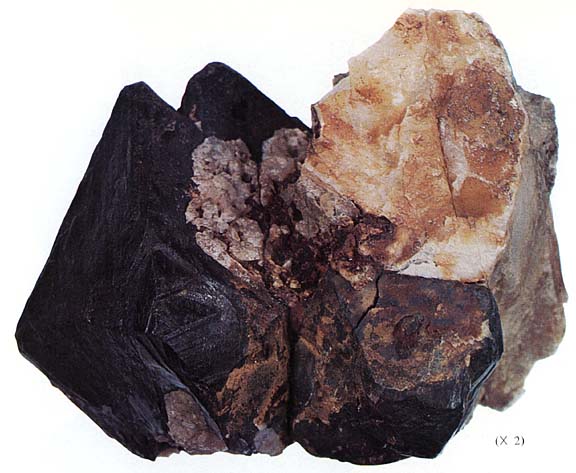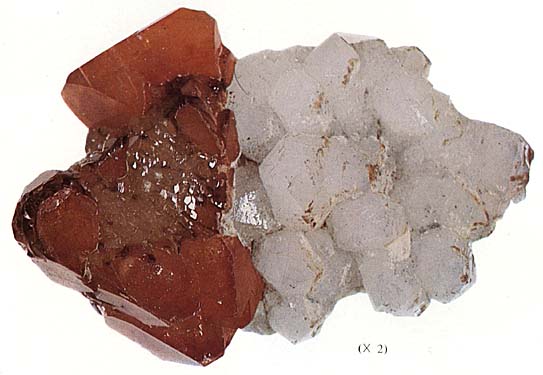Ferberite, Fe[WO4], Monoclinic, P2/c
< Specimens No. VII-1—No. VII-4>
Specimens No. VII-1—No. VII-4, from Otome (Otomezaka) Mine,
Yamanashi Pref., are pseudomorphs of ferberite after scheelite in its original
octahedral form. O. Leudecke (1879) described it by mistake as a new species
with this crystal habit and black in colour with submetallic lustre, and named
it " Reinite " after Professor Rein. These specimens came from a pneumatolytic
tungsten-molybdenum-bearing quartz vein. The pyramidal faces consist of p(111)
and small e(101) (Plate 12).

FERBERITE (No. VII-4) (Pseudomorph after scheelite) Otome Mine, Yamanashi
Pref.
Wolframite, (Fe,Mn)[WO4], Monodinic, P2/c
< Specimens No. VII-5—No. VII-20 >
Specimens Nos. VII-5 & VII-6, from the Nishizawa Mine, Tochigi Pref., occur in a quartz vein in a mesothermal gold-silver deposit, and form thin tabular crystals black in colour.
Specimens No. VII-7-No. VII-11, from the Ebisu Mine, Gifu Pref., are black coloured tabular crystals found in a topaz-fluorite-bearing quartz vein. They are about 5 cm in diameter.
Specimen No. VII-12, from the Ikuno Mine, Hyogo Pref., is black tabular and prismatic crystals included in a white massive quartz from a xenothermal polymetallic deposit.
Specimens Nos. VII-13 & VII-14, from the Akenobe Mine, Hyogo Pref., are black thin tabular crystals included in a glassy massive quartz from a xenothermal polymetallic deposit. Scheelite is associated.
Specimen No. VII-15, form the Komaki Mine, Shimane Pref., occurs in a quartz vein as a massive aggregate of black tabular crystals up to 1 cm in length.
Specimen No. VII-16, from the Cheongyang Mine, Korea, occurs in a drusy cavity in a quartz vein, and forms black tabular crystals with a(100), m(110), t(102) and f(011).
Specimen No. VII-17, from Noungam-ri, Korea, occurs in quartz and forms black tabular crystals with a(100), m(110), t(102), f(011), w(111) and q(121).
Specimens Nos. VII-18 & VII-19, from the Paeknyeon Mine, Korea, form aggregates of black blades embedded in a massive quartz in a pneumatolytic quartz vein. They are 4 to 5 cm in length.
Specimen No. VII-20, from Haranor, U.S.S.R., is black tabular crystals included in a greyish quartz associated with scheelite.
Scheelite, Ca[WO4], Tetragonal, I41/a
< Specimens No. VII-21—No. VII-49 >
Specimens No. VII-21—No. VII-25, from the Kanagase Deposit of the Ikuno Mine, Hyogo Pref., occur in drusy cavities in a quartz vein in a xenothermal polymetallic deposit. The crystals are octahedral with p(111) and e(101), a few millimeters in diameter, and reddish brown to pale brown in colour. Co-existing minerals are wolframite, chalcopyrite, pyrite, sphalerite and stannoidite (Cu8Fe3Sn2S12), the last of which is a massive aggregate of dark brown fine grains as in specimen No. VII-23.
Specimens No. VII-26—No. VII-39, from the Akenobe Mine, Hyogo
Pref., occur in drusy cavities in a quartz vein in a xenothermal polymetallic
deposit. The crystals are octahedral with the combination of e(101), p(111)
and h(313).Though rarely, twinning takes place on a(100) as in specimen No.
VII-29. Scheelite in these specimens is yellowish brown to yellow and transparent.
The largest crystal measures 3 cm in diameter. Associated minerals are wolframite,
pyrite and chalcopyrite (Plate 12, Fig. 86).

SCHEELITE (No. VII-39) Akenobe Mine, Hyogo Pref.

Specimens Nos. VII-40 & VII-41, from the Kuka Mine, Yamaguchi Pref., occur in a quartz vein cutting through a contact metasomatosed deposit, and form aggregates of granular crystals. They are yellowish brown in colour and transparent to translucent. Associated minerals are quartz, pyrite, chalcopyrite and apatite.
Specimen No. VII-42, from the Sanjo Mine, Yamaguchi Pref., occurs in a massive grossular in a contact metasomatosed copper deposit.The crystals are octahedral with e(101), and a few centimeters in size. Its greenish colour is due to inclusions of malachite.
Specimen No. VII-43, from Sannotake, Fukuoka Pref., occurs in a chalcopyrite-bearing
hedenbergite skarn in a contact metasomatosed copper-iron deposit, and forms
grey to yellow octahedra consisting of e(101).
Specimens No. VII-44—No. VII-48, from Neungam-ri, Korea., are isolated megacrystals occurring in a quartz vein. They are yellowish brown to brown, and form octahedra with e(101), up to 10 cm long along the edge.
Specimen No. VII-49, from Haranor, U.S.S.R., is yellowish granular crystals included in quartz associated with wolframite.